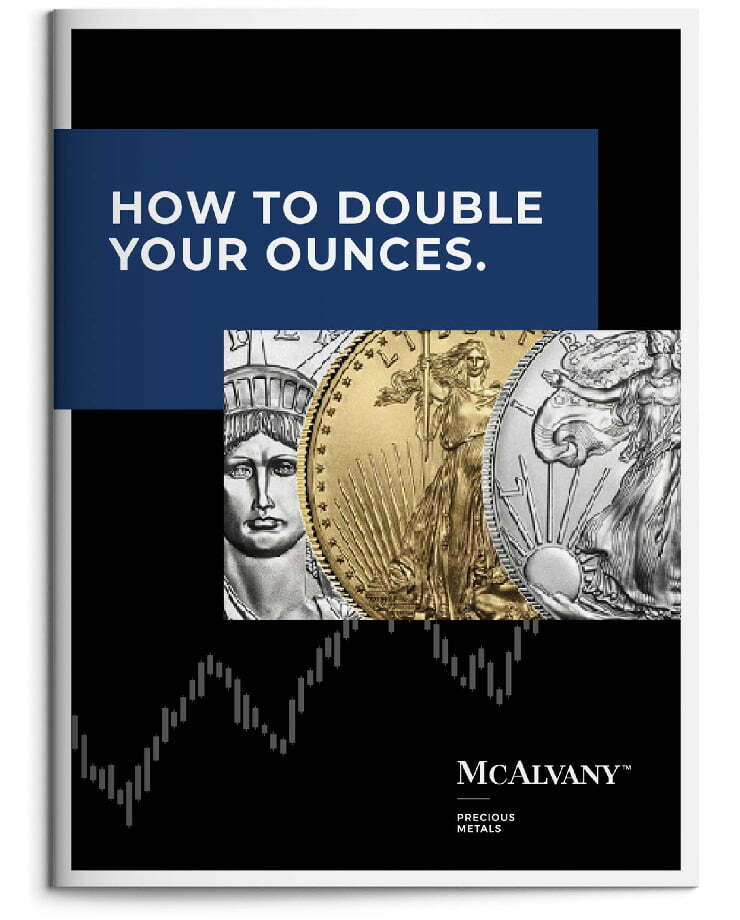Podcast: Play in new window
- Inflation (Devaluation) Chosen As Best Political Answer
- Gold Purchases (Bar & Coin) Up 250% In Germany, 91% In China
- What Is A “Crack-Up-Boom”?
“If you have too little money in credit and growth does not as easily materialize, you risk economic implosion. And that’s if there’s even a hiccup, a small little disruption within the economy. Too much money in credit, and you over-stimulate to the point of tempting fates with economic explosion. And at its extreme, it’s a Von Misean crack-up boom, where the value of your currency is dropping, the price of everything is going higher. That could be the value of stocks, the value of bonds, the value of real estate, the value of commodities—everything is being repriced higher in an extraordinary and rare crack-up boom.” —David McAlvany
* * *
Kevin: Welcome to the McAlvany Weekly Commentary. I’m Kevin Orrick, along with David McAlvany.
David, I was just thinking of when our family used to go to Lake Powell. The first day was a little stressful, getting the boat launched, getting everything ready, but by day three, you really only saw three colors. You saw the blue of the sky, the green of the water, and the red. And when we drove away it was like, wow, is life that simple? Is life that simple?
David: This weekend, similarly, I’m sitting by the lake. First time I’ve been to the lake all summer, I should be there swimming more often, but went for a swim and just sat in the sun and enjoyed the blue sky, enjoyed the breeze. And I thought, I have too many inputs. I’m reading too much. I’m sorting too many details, too many data points, and there’s a certain point at which they just don’t matter anymore. Is it this outcome? Is it that outcome? Is it any outcome? And it’s really helpful just to calm down and be quiet.
Kevin: It’s sometimes really important just to figure out what are the few things that are absolutely important, and then everything else can be sorted out after that. Do you remember when we were training about nine years ago? Now, you kept up with the triathlons. I didn’t. But as far as fitness goes, we were actually paying our dues to be fit. And it’s a lot of time, but it is something that you do to really be fit. You can’t actually race 70-plus miles in the water and on a bike and on foot without doing a little bit of training. But I look back right now and I probably could not do that. And I think about how many young athletes these days spend all that time training, and yet we still see sudden heart attack sometimes with these guys. And I wonder if it was worth it at all. I mean, will it keep you alive longer?
David: I’m registered for a race in September. I think I’ve told you that.
Kevin: Have you been training?
David: I haven’t been training. So, back of mind, there’s consideration, could I do it off the couch? And then that thought of, no, it’s probably not a good idea.
Kevin: No, I don’t think so.
David: I mean, there are a lot of people across the country with ailments related to the condition of their body, inadequate care given to maintenance and diet. We have an obesity epidemic. It feeds a host of medical issues, and it’s unsurprising when heart conditions emerge, other chronic problems persist, and that’s in the context of junk food and excess sugar and very little exercise. And of course if you’re a smoker or you drink excessively, those are compounding factors, force multipliers for bad health.
Kevin: But those are sort of predictable if you’re doing that. What about the guy who’s not doing that?
David: Yeah, more surprisingly is the fit athlete, well-conditioned, carefully obsessive. You might describe them as an exercise fanatic. This is admittedly rare, but they do on occasion keel over from a heart attack.
Kevin: Well, and you had a friend that that happened actually.
David: Yeah. Now, he didn’t keel over, didn’t die. But quite often the silent killer is some pre-existing coronary condition within that sort of athletic type, and they’re typically under the age of 35. It’s one in 40,000 to one in 80,000. It’s a pretty small number, but it’s a sudden cardiac issue. Those kinds of heart attacks, 65% of the people that drop never get back up. It’s death on the spot. Frankly, it sounds like a good reason to skip the next marathon.
Kevin: Well, I’m sure, Dave, we’ll probably get some comments too. It’s not just the genetics. Sometimes people took the vaccine.
David: Well, and it’s not the young athlete that poses a problem to our health system. It’s the aging and infirm. One in four deaths in the US are due to heart disease.
Kevin: Wow.
David: It’s a big number. And the incidence of heart attack increases with age. So males over the age of 50—I should be paying more attention now—but particularly over the age of 65, that accounts for the vast majority of cardiac events.
Kevin: One in four. That’s the whole statistic.
David: Arteries harden, plaque builds, and over time you’re setting the stage for crisis.
Kevin: And this brings in your friend.
David: Yeah, one of my good friends, age 50, just had a heart attack, but that’s not really the reason for the lead-in on health. Rather it’s age and the type of wear you put on the body that ratchets up the probability of crisis events. So, too, I think when you look at the age of a business cycle and the degree of mistreatment within the economy, I think you’re talking about a compounding effect.
Kevin: Well, why don’t we look at 2008, Dave, when we started this podcast, basically. We were in the midst of the global financial crisis, beginning stages of it. And then what we saw after that was the possibility of a depression. And the central bankers came out basically saying they’d do whatever it takes. And now here we are, 2008 to 2025, that’s 17 years, and we really have sort of delayed the hammer. But how much longer?
David: Well, how healthy is the ticker? If the heart is like the economy, the deceiving looks good, feels great. It’s kind of: the investor gloss on the US economy is problematic, and you may not have a comprehensive read on the true condition of the engine. Like you mentioned, 2008, we were in crisis, 2007, things had never looked better. I think it was actually late 2007 you had the Citigroup CEO said, if the music’s playing, you got to get up and dance. I mean, so there’s this expectation of, hey, looks good, music’s playing, get with it.
Kevin: Yet we saw a signal, there was Bear Stearns in the background. It’s like, wait a second. They can’t sell any of their bad debt.
David: So you get simple vitals, and it’s just not the same as a comprehensive set of panels. A basic assessment of vitals. It’s helpful, but it may not tell you all that you need to know. When you want a thorough assessment, you have blood panels done, urine samples. Think of how much data an insurance company collects and how many tests they run to determine their probability of loss from an insured person dying.
Kevin: So what would a comprehensive panel for our economy do right now? I mean, if we really looked and assessed, taking politics out of it.
David: Well, I think that’s where you look at the amount of liquidity in the system, and it’s one of those things that feeds this view that all is well. If there’s lots of liquidity, everything seems to be functioning in a normal fashion. You change the liquidity dynamics and all of a sudden the system functions very differently.
Kevin: So there’s the heart attack metaphor. There’s a liquidity dynamic with a heart attack.
David: Well, for sure. When you think about data and you think about the need for good data, we’ve got a president who was up in arms last week about bad data. Lets the lead at the Bureau of Labor Statistics— Fires them. Data’s bad.
Kevin: “I don’t like your numbers.”
David: And I’m not sure what the president is looking for. Is he looking for true and accurate data or does he want data to confirm his policies? Just like he wants interest rates to support his policy trajectories. This week, Trump is in a rage. He fires the head of the BLS for what he says is bad data. I would argue that everyone knows the data from the BLS has informational deficiencies.
Kevin: I think you’ve eliminated the L out of that many times in the past and just said it was BS.
David: That’s been the case across multiple administrations.
Kevin: Sure.
David: Can the BLS play politics? We talked about this on the Tac Short call this last week. One of the questions was about whether or not the Fed was still independent. And I think they can certainly play politics. They have played politics for sure, but I think there are two reasons to care about the data. One, because you’re trying as an investor to assess risk and avoid cardiac events. And two, because, and this is perhaps less ideal, you’re selling policies to the public. So you care about data because you care about what it says, what it reveals, and you may be leveraging that data to build a case for preferred legislation. Again, leveraging data to prove a point.
Kevin: But when you guys meet, you really need the best data possible. So when Morgan’s there or Doug or Philip, Robert, you guys need the very best data that you can.
David: On a daily basis, we look at 125 data points that are constantly shifting, and try to get a picture, a mosaic of things that are shifting within the financial markets.
Kevin: You try to project. It’s not political. You’re not trying to convince anybody of anything.
David: No. Data integrity is fundamental to us.
Kevin: Exactly.
David: Data, I think, to Trump, is political, as it is for all politicians. You can go back to the ’70s, and that’s certainly the case. Arthur Burns, he bent the knee to the Nixon administration in an effort to gin up economic activity and improve the economic vitals.
Kevin: Then we got high inflation after that.
David: Ultimately got the inflationary 1970s, the system strain of a system abused by stimulants. Certainly on the front edge, it looked pretty impressive, and that’s what Nixon wanted, and that’s what he got. Ultimately, the unintended consequences of loose monetary policy, not healthy for the general public.
Kevin: So, let me ask you, because we saw the rage against Powell last week. Do you think if Powell were to actually bend, and rates were to come down in this environment, that down the road that would turn into almost a hyperinflationary event?
David: Yeah. I mean, it’s a possibility. Trump’s rage against Powell has everything to do with turbocharging the economy, and lower rates certainly do that. An observation from last week’s Tactical Short call was that we have inflationism built into the system today. This is the nature of our central bank system. It’s the nature of our fiat system. It’s the nature of a credit system that runs extraordinarily loose. We are tempting fate, as Doug said in the Q&A with a crack-up boom.
Kevin: I even remember in economics, taking economics back in the 1980s, we were told that you can’t have the kind of economy we have without inflationism. We’re just told, “Hey, it’s good for you. You’re going to lose 2 to 3 to 5% of your buying power every year. Just get used to it.”
David: An amazing event happened in the early ’90s. The Bank of New Zealand popularized inflation targeting for the first time, and now that’s become the rage. All central bankers use an inflation target, and they say that 2%—a typical target—will improve economic performance.
Kevin: Do you remember the Gary Larson cartoon with the deer standing there with the target on his chest, and it says, “Bummer of a birthmark, Hal?” That’s what I think of an inflation target. It’s like, “Hey, what’s your target from one central banker to another?” Bummer of a birthmark, Hal. So, let’s go back to heart attacks because, in all honesty, liquidity is everything in economics and in the functioning of our body. So, as long as liquidity is flowing, that means that we can continue this way. Correct?
David: Yeah, and we bring up liquidity as a critical aspect to market behavior, as a critical component for economic activity, frequently. Of course, lack of liquidity, the abrupt stoppage of flows within the financial markets, that is the proverbial heart attack. The Fed’s interventions thereafter are like chest compressions and perhaps even stimulative shock. You put the paddles on. You let the electricity flow, try to get the heart pumping again.
Kevin: Right, like 2011.
David: Keep the engine alive, and the economic heartbeat—you’ve got to keep it ticking.
Kevin: But, liquidity actually feeds on itself. It turns into leverage. It’s not just the liquidity you put into the system. It’s the liquidity multiplier that occurs after that.
David: That’s the nature of a fractional reserve banking system. You create a little bit of liquidity, and there is a multiplier effect. It also works in reverse. So when you take liquidity away, there’s also a multiplier effect. That’s one of the reasons why there is a fear of deflation. If there’s a lack of liquidity, and you see a contraction in prices or a liquidation event, oh boy, that’s when all of a sudden everyone’s in a panic because just as fast as it multiplies one direction, it contracts the other.
Kevin: Well, you remember September 11th, 2001, Bush, after that, sent everybody $100, and said, “It’s your patriotic duty to spend.”
David: Go spend.
Kevin: That was that kind of fear at that time, that depression fear.
David: Right, to create a multiplier effect, to keep positive economic activity going. We have extraordinarily loose financial conditions today, which is to say plenty of blood flow. So, that’s true. Extraordinarily loose conditions, particularly given the elevated level of interest rates, if you think about what was attempted in raising rates, it was to tighten financial conditions. Very interestingly, intriguingly, even though rates are higher, financial conditions are still extraordinarily loose.
Kevin: So when you have these loose financial conditions, again, likening it to blood, if it’s too loose, you start getting nosebleeds every day, right?
David: Yeah. Sometimes five times a day.
Kevin: You can’t seal a wound. Right. Right.
David: You just hope you’re not Genghis Khan, bleeding out. You may be a battle hardened warrior that—
Kevin: But that’s how he died, right?
David: A nosebleed.
Kevin: That’s how he died. Wow.
David: Leverage acts as a performance-enhancing substance within the financial markets. It increases activity. It improves results. The financial markets appear to be extra healthy. If you look around this, what we have, we have markets at all time highs. We have low levels of concern registered in the VIX. We have very tight credit spreads. We have resilience. We’re passing the stress test. That can happen even as an artery is nearly fully blocked. The heart can power through. Performance can be maintained. Believe it or not, you can go to the doctor, get a stress test done, and the next week die of a heart attack because you had blockage, and the stress test doesn’t catch blockage.
Kevin: But, it is a liquidity event when it occurs. It can be sudden, but it shuts the liquidity down.
David: Yeah. So, be aware of the liquidity event. When liquidity dries up, it’s a big deal. The engine—the heart—seizes. Politicians today are beyond Keynesian. The classic Keynesian policy is, when you get into a problem, you introduce more liquidity to paper over the problem, essentially. I say they’re beyond Keynesian because it’s not just intervention in the midst of crisis. It’s now liquidity provisions, ample now and always. It’s not just when you need it. It’s as a normal course of business. They don’t just concede the need for artificial stimulus in the event of emergency. They prefer the stimulus all the time to erase the ebb and flow of the business cycle.
Kevin: Okay, but let’s look at the mandates for the Fed. One of them has to do with jobs. I mean, the jobs’ numbers changed dramatically toward the end of the week last week. The jobs’ numbers are not looking good at least on paper. I don’t know whether that’s political or not.
David: Well, and we had the ADP numbers which were suggesting weakness even though the non-farm payroll numbers for weeks and months were suggesting we’re just fine. Everything is fine. ADP—this is the private survey—was suggesting, “actually, it’s not that great. Labor market is not as strong as you think it is.” Last week’s job numbers, less than stellar, 73,000 versus north of 100,000 expected. The big issue was the two-month backward-looking revisions.
Kevin: The revision’s down. Huge—
David: Subtracting 258,000 jobs. That was the real doozy. The Friday market freakout was enough to challenge the upper trajectory of the markets, and reverse the all-time highs set in the S&P and NASDAQ. Of course, those were just before the Powell meeting on Wednesday. So all-time highs on Tuesday, we close lower that day, and it’s an important technical setup. It doesn’t guarantee that this time we’re going lower, but that possibility certainly exists. So, from one day to the next, price action suggests on Tuesday we have nothing to worry about. Then you roll around to Thursday, Friday, how quickly the health narrative can change. Thursday, Friday challenge the economic health narrative. Certainly, the indicators of systemic stress were perking up.
Kevin: It might be saying something different. That seems to be happening right now in the market as well. It may be hitting all-time highs, but where are the people?
David: Well, a lot of the people are on vacation. I mean, you’ve got retail investors who are certainly active, and as a percentage of trades, you’re setting records in terms of retail participation. Your institutions, your Wall Street traders vacation. It happens. Late July, early August. So, you’ve got new highs set on low summer volumes, which can be problematic. August trading is inherently suspect because the volumes are lower than normal. It’s easier to push the markets around, push them to higher levels, takes less buying to do so. Again, that’s summer absenteeism from professional traders, which is typically at its peak late July, early August. What happens this fall will be telling. As volumes return, we’ll see if the institutional bias differs from that of the retail investor.
Kevin: So, let’s look at another signal. We’ve talked about liquidity, which, there’s plenty right now. We’ve talked about the job numbers, which are down, but some of that might be politic. How about the signal for gold? I mean, gold really is the signal that we use probably more than anything else, because that’s what your family’s done since 1972.
David: I think that metals markets are still signaling that not all is well. The Q2 gold statistics from the World Gold Council show the importance of investor demand. We’ve highlighted the outsized footprint of central banks, the reserve managers loading up on ounces, diversifying away from the U.S. dollar and Treasuries. That remains relevant. The ETF purchases kept demand in the second quarter on the increase.
Kevin: Well, and you’ve said numerous times, when the ETF investor starts coming back, that’s investor interest. That mining, silver, those types of things, it takes the retail investor.
David: Yep. So total gold demand, including over-the-counter investment estimated at 1,249 tons. In volume terms, that was a 3% increase quarter-over-quarter, and in dollar terms a 45% increase. Jewelry, along with coin and bar demand, dropped a cumulative 8.5%, if you’re measuring it in ounces. But with the Q2 increase in price, it actually increased by roughly 5%. So again, we’ve had a huge move higher in price, and there’s just not as many dollars flowing. Coin and bar demand declined notably 37% in the U.S.
Kevin: We have really felt that. We’ve seen a lot of liquidations, but not a lot of demand right now, that’s causing the premiums to be low.
David: Yep. Also declined in Turkey by 23%. Flat in Japan. Major increase in the Middle East, 55%. 91% increase in coin and bar demand in China. 250% increase for coins and bars in Germany.
Kevin: I think you should repeat that, there’s a 250% increase in demand for coins and bars—
David: In Germany.
Kevin: In Germany.
David: Right.
Kevin: What do they see that we’re not seeing?
David: And actually the regional average, if you’re looking at all of Europe, 128.4%.
Kevin: So all of Europe?
David: Decent increase across Europe, Germany in particular. The trend in the U.S. was fascinating. Coin demand has been low enough for many products to trade at a discount to spot, that’s the melt value of gold, causing many traders to pick up inventory at a discount, and scrap it. Actually send it to the melting pot.
Kevin: We’re trying to rescue those coins, Dave. We’ve been picking up inventory, too, without it, but We’re trying to keep those coins from getting melted down.
David: And the trade is this: if you can buy it at a discount, return it to the mints at the spot price. You bought it at a discount, you sold it at spot price, you don’t have to have a retail client come in and buy the product. It’s just being melted and turned into future inventory for the mints.
Kevin: That’s including junk silver, junk silver right now is being purchased and melted down for the copper.
David: That’s right.
Kevin: 10% copper.
David: 10% copper for free, up until last week’s move lower in copper. And you’re talking about copper near all-time highs. Sales are incredibly low in the U.S. Trading profits are high, with these dynamics being uniquely attached to the coin and bar segment in the U.S. And there are, I would note, some compelling values at present, compelling enough to bring my dad off the sidelines and position in junk silver. To be honest, I can’t remember a time in the last 20 years where he bought junk silver.
Kevin: He’s not a silver fan.
David: No.
Kevin: He loves his gold, but he’s not a silver fan.
David: His question is always, “How much of it can I run with?” And I mean, at 85 you wonder why he’s still asking that question, but still.
Kevin: Well, he could run with quite a bit. Doesn’t he teach at the orphanage, the weightlifting class.
David: Yeah. He’s in the weight room a couple of times a week
Kevin: At 85 years old. Okay. But let’s go back, something that you can run with real easily is an ETF. So let’s say you’re buying gold, and all you have is just an ETF. You said that ETF buying has increased during this period of time where coin and bar has decreased.
David: Yeah. The ETF purchases remain sizable. And this is key because this is asset allocators, not individual investors. Asset allocators looking to hedge portfolio risk of all kinds. So it’s inflation risk, it’s geopolitical risk. The first half figures, so through June, took ETF demand to nearly 400 tons, 397 tons. That’s the strongest since 2020.
Kevin: Wow. Since COVID.
David: Yep. And prior to that, the first half of 2016, if you remember gold bottomed at 1,050, December of 2015. And then began recovering early 2016 with a huge allocation in ounces in the first half of 2016. So strongest in recent memory since 2020 when COVID demand spiked interest globally. Interestingly, it’s not the same dynamic with coins and bars. North American ETFs added 73 tons. So it’s not the retail investor, it’s the institutional investor taking an interest in allocating via the ETFs. 73 tons in the U.S., 24 in Europe. Asian tonnage bumped 28%, or roughly 70 tons. Big, big bump higher than the ETFs in China.
Kevin: But what you’ve also said numerous times is when you see mining stocks and silver, not only the ETFs, you’re seeing the introduction of the Western investor again. Because we see that the European investor and Asian investor have been buying physical metals.
David: And we’re looking for confirmation of a trend. I mean, it’s one thing to be perpetually bullish on the metals, it’s another to see confirmation of activity. Price action shows up in different forms with different products. We’ve argued, going back to 2024, that ETF demand would signal the return of the Western investor. We have similarly argued that silver outperforming gold would signal the return of the Western investor.
Kevin: Well, and even though the gold-silver ratio is still, silver’s very low relative to gold. There has been a change because we got to, what, 108 recently. And now we’re in the 90s.
David: 108 to 88.
Kevin: 88. Yeah.
David: 108 to 88. And lastly, we’ve argued that a fresh or a refreshed bull market dynamic would be evidenced in the performance of the mining complex. So again, gold miners, silver miners are a unique space where western investors are the primary people putting money in that space. And if you begin to see outperformance there, yes, the western investor is beginning to come back in.
The HUI, the Gold Bugs Index, as it’s called, is now higher year-to-date by 55%. I would say that at this point we have evidence from all three areas, ETF flows, silver relative to gold, and just in price performance, the breakout over $34 was very significant. Ran to almost 40, and is backfilling now. Probably will retest the 34 before it moves much higher. And of course, the miners are that third confirming factor.
Kevin: When we have our meetings, Morgan usually gives a briefing. And he was talking about debt sustainability right now. So not just the liquidity aspect, but there is a point where even if the liquidity didn’t dry up, is the debt sustainable? And gold and silver and mining stocks might be showing that there are some breaks in that dam.
David: Yeah. And I think many of the structural shifts that favor precious metals’ outperformance and justify a healthy allocation to precious metals, they’ve been well documented in MWM’s missives, the Hard Asset Insights are my co-portfolio manager, mining equity analyst, Morgan Lewis covers—
Kevin: Every Friday. Every Friday he puts that out.
David: And you often hear us discuss liquidity as a key to broad market performance. But just as often you hear us discuss the sustainability of debt. Really it’s the unsustainability, in truth. Limits exist, and as we talked about last week, you just don’t know what the limits are until after the fact.
Kevin: We read a book, oh, 10 years ago by Carmen Reinhart and Rogoff called This Time is Different. And it talked about, what was it, 600, 700 years of how countries have dealt with debt. And almost always, there’s a default. Now, if you don’t default, like the United States doesn’t really have the option of defaulting on its Treasuries, so what they do instead is they devalue. So the two D’s, there’s default or devalue.
David: Right. The classic policy choice to avoid the formal default is to use inflation as a policy tool. And basically what you’re doing is imposing losses more broadly on an entire population, rather than a select few creditors. That form of default via inflation, via decline in purchasing power, it’s what you can expect—
Kevin: Called repression. Yeah, financial repression.
David: Repression, too, brings in the idea of controlling the yield curve and managing your interest rate expense. So if inflation spreads out the cost to pay back that debt across the entire population, yield curve control and financial repression are targeting specific segments of the population to help pay that price.
Kevin: So the simplification of that trick is just pay lower interest rates than the inflation rate, and you’re good.
David: Yeah. Debts in that scenario are a somewhat fixed component. The currency at its fluctuation, that becomes the helpful adjustable part that alleviates financial pressure over time. Seeing the limited options that policymakers possess, and sorting out the less than politically palatable options that can be exercised, it’s not unreasonable to surmise that running an economy hot and running inflation statistics also hot are part of the solution for our debt overhang. To effectively manage down our debt burden you’re talking about a 50 to 65% devaluation of the US dollar.
Kevin: Which would show up in the gold price.
David: You’re going to show up in the gold price, but it’s not a proportional gain. A 50 to 65% devaluation of the dollar is a 300 to 400% gain in price. So, how that happens, on what kind of a time frame, remains to be seen, but there is a disproportional effect as you’re cutting back the value purchasing power and what that magnifies in terms of the cost of all goods and services.
Kevin: Do you think that’s what gold is signaling right now?
David: I think the signal we’ve asked our listeners, our clients, to focus on goes far beyond statistics tallied by a government agency. You mentioned it earlier, we talk about the BLS and focus on the B and the S, because we fired the BLS a long time ago. And I think the signal that we’re asking people to focus on, that signal goes beyond the current hype in the financial markets.
Last week, we talked about valuation metrics, the Buffett ratio, the cyclically adjusted price earnings ratio, price to sales, your standard price to earnings. These are valuation metrics we mentioned. They were echoed later that week as sort of a helpful look at where the markets are at and where the danger factors lie by Mohamed El-Erian in the Financial Times. And it cuts through the noise completely, the gold price does. Gold is telling us that a global collective made up of individual investors, now of institutional asset allocators, and for now many years central bank reserve managers, are confident that a world awash in money, a world awash in credit is not always a stable world.
Kevin: I remember when I was a kid, I was watching the great Wallenda, I think he was walking a tightrope back down in Mexico City.
David: Rolenda? Rowenda?
Kevin: Wallenda.
David: Wollenda?
Kevin: Wallenda. Wallenda. Yeah.
David: Whoa-Linda.
Kevin: Yeah.
David: Okay.
Kevin: And it was the Wallenda family, and I remember he fell between two buildings. It was a terrible thing to see, but he had walked tightropes like that over and over and over, but just a slight variation. It seems right now that this liquidity, debt sustainability, jobs market thing, it sounds like we’re really where everything has to work perfectly right to get across that tightrope. Otherwise, you mentioned crack-up boom earlier. Okay, Ludwig von Mises talked about a crack-up boom. Is that a possibility?
David: Fascinating that that came into the conversation on Tac Short call last week. On the one hand, if you have too little money in credit and growth does not as easily materialize, you risk economic implosion. And that’s if there’s even a hiccup, a small, little disruption within the economy. Too much money and credit, and you overstimulate to the point of—
Kevin: Explosion.
David: —tempting fates with economic explosion, right?
Kevin: Right.
David: And at its extreme it’s a von Misean crack-up boom, where the value of your currency is dropping, the price of everything is going higher. That could be the value of stocks, the value of bonds, the value of real estate, the value of commodities. Everything is being repriced higher in an extraordinary and rare crack-up boom.
Kevin: Because it’s been stimulated. It’s that continual addiction to stimulation.
David: Right. The bias towards too much stimulus is the bias to obfuscate underlying health conditions and focus on metrics that prove positive performance, because what you’re getting is nominal growth in all things. Nominal growth in the value of assets, nominal growth in GDP. Inflation is this thing which proves we’re healthy and we’re passing the stress test and all is well, we’re ready for the next marathon. And frankly, explosion in price is seen as a positive. Take the $1 trillion market cap for Microsoft, which then becomes two trillion.
Kevin: If you’re a stock owner.
David: And then 3 trillion.
Kevin: Yeah.
David: And last week, $4 trillion-
Kevin: Wow.
David: —4.1 trillion in the market cap for Microsoft. No one minds that because the nominal value looks healthy, it looks healthy. Indeed, it’s interpreted as growth. And for a select few, it is growth, it’s portfolio growth.
I fear that the price of gold is telling us to mistrust the obvious and look through the price explosions to real rates of return. In this respect, gold has consistently been suggesting that we are edging closer to a valueless dollar, and with that comes limitless prices. Perhaps, a reassessment of economic vitals is what we should be focusing on. We need a doctor. We need somebody to run a full panel. The one thing we don’t need is a doctor of economics.
* * *
Kevin: Yeah. Well, you’ve been listening to the McAlvany Weekly Commentary. I’m Kevin Orrick, along with David McAlvany. You can find us at mcalvany.com and you can call us at 800-525-9556.
This has been the McAlvany Weekly Commentary. The views expressed should not be considered to be a solicitation or a recommendation for your investment portfolio. You should consult a professional financial advisor to assess your suitability for risk and investment. Join us again next week for a new edition of the Mcalvany Weekly Commentary.
















